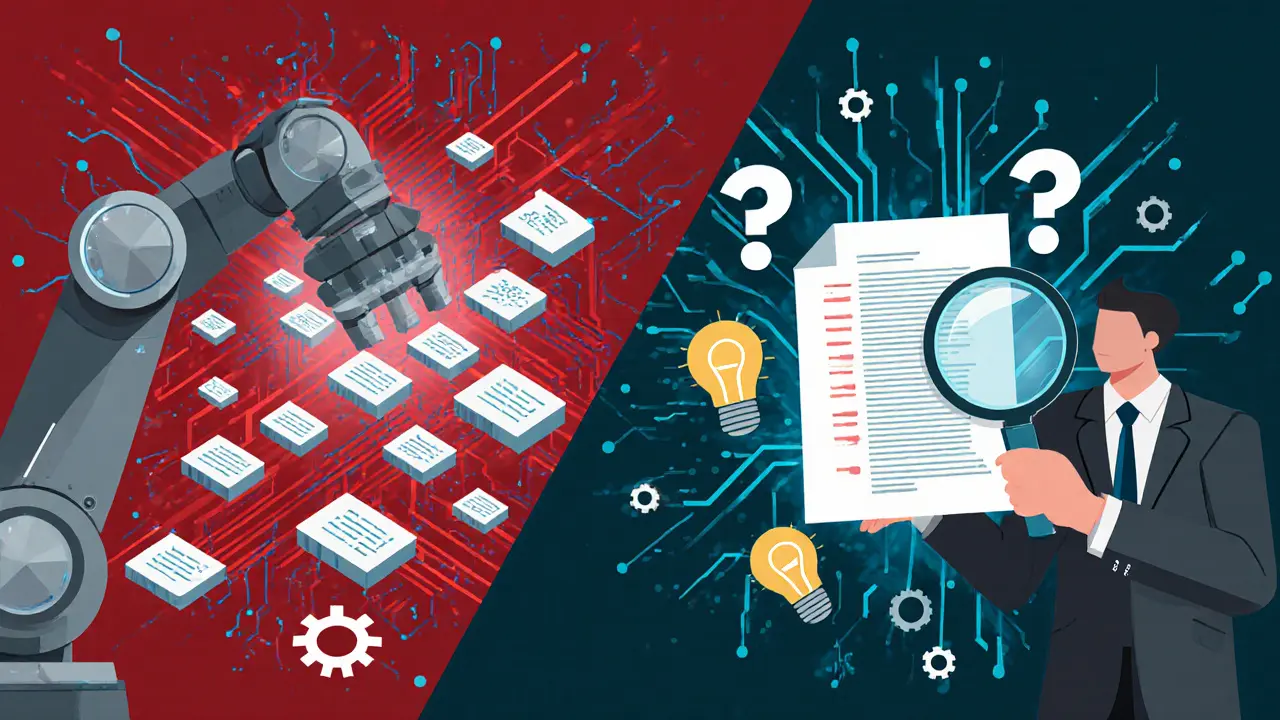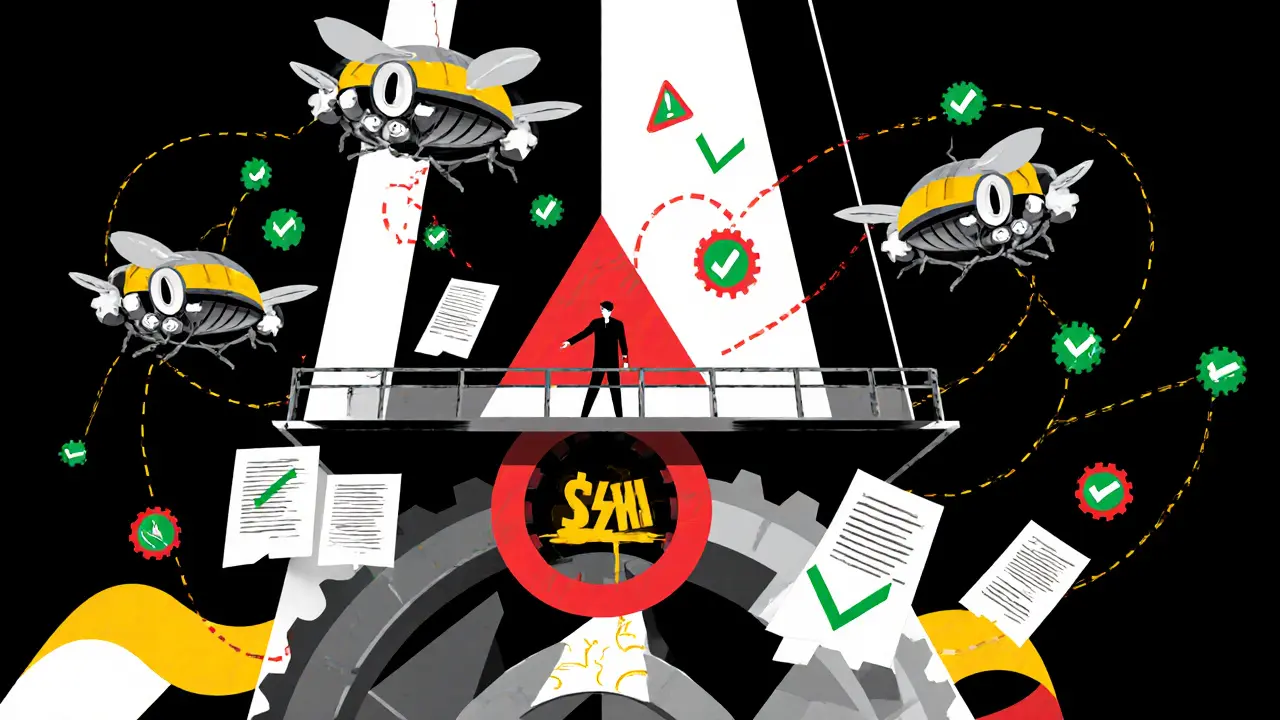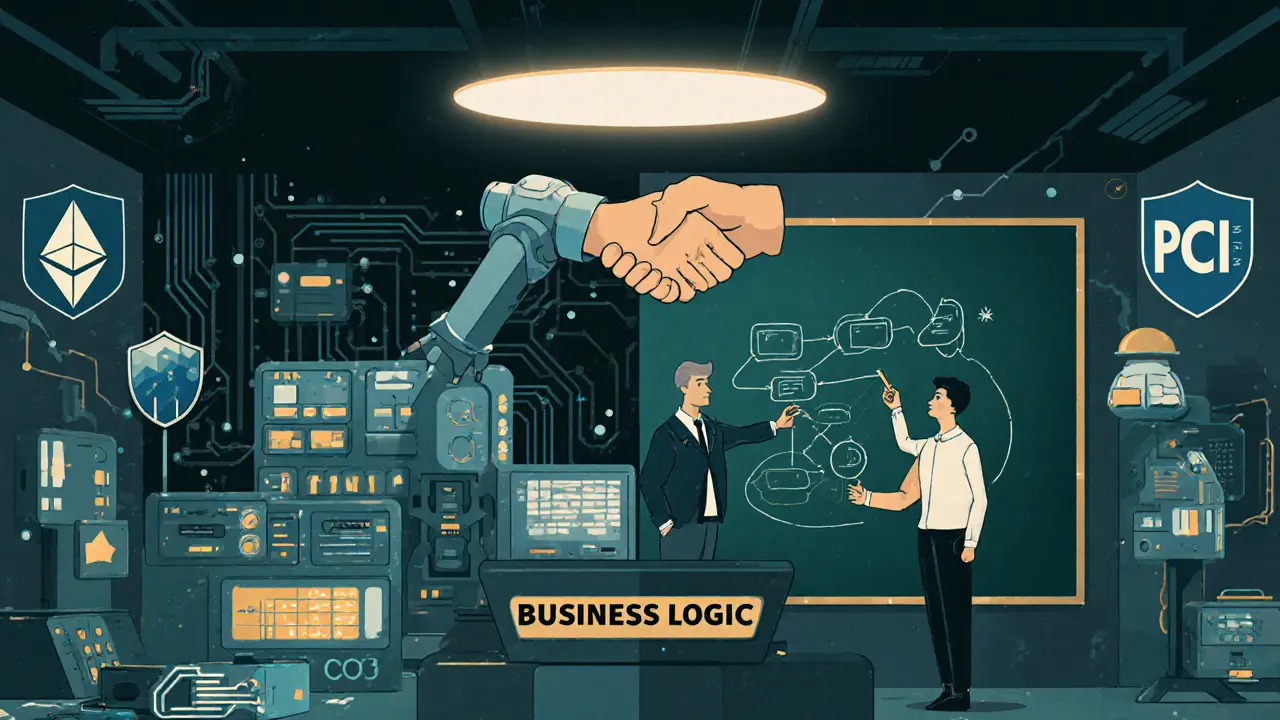Automated vs Manual Security Auditing in Blockchain: What Works Best Today
 Apr, 22 2025
Apr, 22 2025
Security Audit Cost Calculator
Your Project Details
Audit Comparison
Automated Auditing
Cost per scan: $5,000
Scans per month: 30
Total monthly cost: $150,000
Coverage: 100% of code and configuration
False positives: 15-30%
Manual Auditing
Cost per audit: $20,000
Audits per year: 4
Total annual cost: $80,000
Coverage: 60-80% of code
False positives: Near 0%
Hybrid Approach
Automation cost: $12,000
Manual audit cost: $16,000
Total annual cost: $28,000
Coverage: 100% automated + 100% manual review
False positives: Reduced by 45%
Cost Savings Analysis
Automated auditing saves $0 annually compared to manual audits, with 0 hours saved.
Using a hybrid approach saves $0 annually compared to manual audits, while providing superior coverage.
When you’re securing a blockchain system, you don’t just need tools-you need strategy. Automated security auditing runs nonstop, scanning code, configurations, and smart contracts 24/7. Manual auditing brings in experts who dig into logic, intent, and hidden flaws no algorithm can spot. The question isn’t which is better-it’s how to use both the right way.
How Automated Auditing Works in Blockchain
Automated auditing tools scan blockchain networks, smart contracts, and wallet configurations using predefined rules and machine learning models. Platforms like Scytale and Secureframe connect directly to your blockchain nodes via APIs, pulling data from Ethereum, Solana, or custom chains without interrupting operations. These tools check for known vulnerabilities: reentrancy bugs, unchecked external calls, integer overflows, and improper access controls-all the common mistakes in Solidity code.One automated scan can process 50,000+ smart contract components in under 30 minutes. Compare that to a manual review of the same scope: 200+ hours of human time. For teams running decentralized applications with frequent updates, this speed isn’t optional-it’s survival. Automated systems also provide daily compliance reports, flagging deviations from SOC 2, GDPR, or PCI DSS standards in real time.
Most automated tools generate false positives between 15% and 30%, according to NIST SP 800-115. That means for every 10 alerts, 2 or 3 might be noise. But they don’t miss anything. If a contract has an exposed function or a misconfigured permission, the tool catches it. No exceptions. That’s why 68% of Fortune 500 companies now use automated auditing tools, up from just 32% in 2020.
Where Manual Auditing Still Wins
No matter how advanced the software, it can’t understand business context. A manual auditor looks at a smart contract and asks: Why does this function exist? Who should be able to call it? What happens if this fails during a market crash?Manual audits uncover logic flaws that automated tools ignore. TechMagic’s 2024 testing found that human auditors spotted 32% more business logic vulnerabilities than automated systems in complex DeFi protocols. Think of a yield aggregator that allows users to deposit tokens, but doesn’t verify if the withdrawal amount matches the actual balance. An automated scanner might see valid syntax and pass it. A human sees the flaw: someone could drain funds by exploiting the math.
Manual auditors also validate compliance beyond code. They interview team members, review internal policies, check how keys are stored, and assess incident response plans. For blockchain projects aiming for institutional adoption, regulators don’t just want clean code-they want documented processes. A CISSP or CISA-certified auditor can provide that.
But manual audits are slow and expensive. A full penetration test costs between $15,000 and $25,000 and takes weeks. You can’t run one every time you push a new contract. And findings vary between auditors-34% of manual audit practitioners on Capterra report inconsistent results across different teams.
Cost, Speed, and Coverage: The Numbers Don’t Lie
| Factor | Automated Auditing | Manual Auditing |
|---|---|---|
| Speed | Minutes to hours | Days to weeks |
| Frequency | Continuous (24/7) | Quarterly or biannually |
| Cost per audit | $3,000-$8,000 | $15,000-$25,000 |
| Coverage | 100% of code and config | Typically 60-80% |
| False Positives | 15-30% | Near 0% |
| Business Logic Detection | Low | High |
| ROI Timeline | 6-9 months | Not applicable (one-time) |
Organizations using automated tools save an average of 300 hours per year on compliance tasks. Secureframe’s data shows 85% of users cut annual costs by over $127,000. That’s not just efficiency-it’s competitive advantage. Meanwhile, the global market for security automation is set to hit $9.2 billion by 2028, growing at nearly 20% yearly. Manual auditing? It’s growing at 4.1%-and mostly because legacy systems still need it.

The Hybrid Approach: Why Most Experts Agree
The smartest teams don’t pick one. They use both. Start with automated scanning to catch the low-hanging fruit: misconfigured wallets, public functions, outdated libraries. Run these scans every time code is pushed. Then, bring in a human auditor every quarter to review complex logic, user flows, and regulatory alignment.One financial services firm using a blockchain-based payment system reduced PCI DSS prep time from 14 weeks to 3 weeks by automating 80% of the checks. But they kept manual audits for the core payment routing logic-because regulators demanded it. That’s the pattern: automation for scale, humans for judgment.
AI-powered tools are making hybrids even better. Scytale’s new Scy AI Agent uses natural language processing to interpret audit evidence and reduce false positives by 45%. It doesn’t replace auditors-it makes them faster. NIST’s upcoming update to SP 800-53 (due December 2024) will officially recognize continuous automated monitoring as equivalent to periodic manual audits for many controls. That’s a major shift.
What Happens When You Rely Only on Automation
There’s a dangerous myth: “If the tool says it’s clean, we’re safe.” That’s how breaches happen.Sonrai Security documented 14 major blockchain breaches in 2023 where automated scans showed no issues-but critical vulnerabilities slipped through. In one case, a DeFi protocol had a flaw in its staking reward calculation. The code looked correct. The automated scanner passed it. A human auditor later found that the math didn’t account for edge cases during high volatility. Users lost $47 million.
Automation doesn’t think. It follows rules. If your rules are incomplete, or if your contract does something unexpected, the tool won’t know. That’s why every automated scan needs human validation. Especially in blockchain, where a single line of code can cost millions.

How to Build Your Own Audit Strategy
If you’re starting from scratch, here’s how to build a practical audit plan:- Start with automation: Pick a tool like Scytale, Secureframe, or CertiK. Integrate it into your CI/CD pipeline. Run scans on every commit.
- Set thresholds: Only block deployments if critical vulnerabilities are found. Let medium and low issues go to a review queue.
- Schedule quarterly manual audits: Hire a certified firm for deep logic reviews, especially on core contracts and token economics.
- Track false positives: Build a knowledge base of common false alerts. Train your team to ignore them.
- Document everything: Even automated results need records for compliance. Use tools that export audit trails in PDF or JSON.
Don’t wait for a breach to act. The cost of a single exploit can wipe out years of savings. Automation gives you speed. Manual audits give you trust. Together, they give you security.
What’s Next for Blockchain Security Auditing
By 2027, Gartner predicts 90% of security audits will be hybrid. Automated tools will handle 70-80% of technical checks. Humans will focus on business logic, regulatory alignment, and threat modeling.Blockchain projects that treat auditing as a one-time box-ticking exercise are already falling behind. The winners will be those who treat it as an ongoing process-automated for scale, human for safety.
The future isn’t automated or manual. It’s automated and manual. And if you’re not using both, you’re not really securing your blockchain-you’re just hoping it holds up.
Can automated tools fully replace manual security audits in blockchain?
No. Automated tools are excellent at catching technical flaws like code vulnerabilities and misconfigurations, but they can’t understand business intent or complex logic flows. Manual audits are still required to identify issues like flawed token economics, improper access controls in multi-sig wallets, or logic errors in DeFi protocols. The most secure systems use both: automation for speed and coverage, humans for judgment and context.
How often should I run automated security scans on my blockchain project?
Run automated scans on every code commit. For blockchain projects with frequent updates, this means multiple times per day. Tools like Scytale and CertiK integrate directly into CI/CD pipelines to scan smart contracts automatically before deployment. At minimum, schedule daily scans for live mainnet contracts to catch configuration drift or third-party dependency changes.
What’s the average cost of a manual blockchain security audit?
A comprehensive manual audit by a reputable firm typically costs between $15,000 and $25,000. This includes reviewing smart contracts, wallet architecture, tokenomics, and compliance alignment. For larger protocols with multiple contracts, costs can exceed $50,000. Compare that to automated scans, which cost $3,000-$8,000 per full environment scan and can be run repeatedly without added cost.
Are automated security tools reliable for DeFi protocols?
They’re a necessary starting point, but not sufficient. DeFi protocols involve complex interactions between contracts, price oracles, and user actions-areas where automated tools often miss critical flaws. A 2024 study by TechMagic found that automated scanners missed 32% of business logic vulnerabilities in DeFi apps that manual auditors caught. Always pair automated scans with expert manual reviews for DeFi systems.
What certifications should I look for in a manual blockchain auditor?
Look for auditors with CISSP (Certified Information Systems Security Professional) or CISA (Certified Information Systems Auditor) certifications. These indicate formal training in security frameworks and compliance. Many top blockchain audit firms also require their auditors to have completed specialized blockchain security training, such as ConsenSys Academy’s Smart Contract Security course or OpenZeppelin’s certification program. Always ask for past audit reports and client references.
How long does it take to see ROI from automated security auditing?
Most organizations see a return on investment within 6 to 9 months. Secureframe’s data shows that companies save an average of 300 hours annually on compliance tasks and reduce audit preparation time by over 50%. For teams spending $15,000+ per manual audit, switching to automation cuts costs by 60-80% over time. The biggest savings come from preventing breaches-avoiding just one exploit can pay for years of automation tools.
Brett Benton
November 2, 2025 AT 01:49Man, I wish I'd known this before I got burned by a 'clean' audit last year. Automated tools are great until your $2M liquidity pool vanishes because the scanner missed a math overflow in a yield farm. Humans still win when it comes to asking 'why is this here?'
Jason Coe
November 3, 2025 AT 17:17I've been running Scytale on all our contracts since Q1 and honestly? It's a game changer. We catch 90% of the dumb mistakes before they hit mainnet-wrong access modifiers, unguarded external calls, deprecated libraries. But here's the kicker: last week, it flagged a 'potential reentrancy' that turned out to be a false positive because of our custom gas optimization. Took our lead dev 45 minutes to prove it was safe. So yeah, automation is mandatory, but you still gotta know your code. I keep a running doc of false positives now-team uses it to train the model. Also, if you're not scanning on every commit, you're basically playing Russian roulette with your users' funds. Just sayin'.
Beth Devine
November 3, 2025 AT 19:29This is such a solid breakdown. I work with early-stage DeFi teams and I always tell them: automation first, human review second. It’s not about choosing one over the other-it’s about layering. Automation gives you speed and consistency. Humans give you peace of mind. Together, they turn fear into strategy.
David Roberts
November 4, 2025 AT 01:22Let’s be real-automated tools are just glorified regex scripts with ML lipstick. They can’t comprehend intent, context, or the existential dread of a dev who just deployed a contract without testing the withdrawal function. NIST says false positives are 15-30%? That’s just the tip of the iceberg. The real vulnerability is institutional over-reliance. We’re building financial infrastructure on top of code that thinks ‘valid syntax = safe.’ That’s not security. That’s optimism with a API key.
Jessica Hulst
November 4, 2025 AT 21:01It’s funny how we treat code like it’s a math problem when it’s actually a social contract. Automated tools follow rules. Humans ask why the rules exist in the first place. One scans for reentrancy. The other wonders why the protocol lets a single wallet control 70% of the treasury. The former prevents exploits. The latter prevents revolutions. We keep forgetting that blockchain isn’t just about cryptography-it’s about trust. And trust? That’s not something you can scan for.
Brian McElfresh
November 6, 2025 AT 15:12They’re lying to you. The whole automated audit industry is a scam funded by VC money. You think these tools are detecting vulnerabilities? Nah. They’re detecting your wallet balance. Every time you run a scan, they’re logging your contract addresses, feeding them to honeypots, waiting for you to deploy. Then-boom-your liquidity gets drained by a bot that knew exactly where to strike because your ‘secure’ audit tool told them where to look. I’ve seen it happen. They call it ‘security.’ I call it surveillance with a compliance badge.
Kaela Coren
November 7, 2025 AT 08:14The data presented is methodologically sound. Automated systems demonstrate statistically significant improvements in coverage density and temporal frequency. However, the absence of inter-rater reliability metrics in manual audits introduces a latent variable that may skew ROI comparisons. Furthermore, the normalization of false positive rates across heterogeneous contract architectures remains unaddressed. A longitudinal study controlling for team size and codebase complexity would strengthen the generalizability of these findings.
alvin Bachtiar
November 8, 2025 AT 05:22Automated tools are the duct tape of blockchain security. They hold the damn thing together until the next exploit. But let’s not pretend they’re the foundation. Manual auditors are the surgeons-cutting through bullshit, finding the rot no algorithm can smell. I’ve seen contracts that passed every scanner with flying colors… and then got drained because the dev thought ‘this function is only called internally’… but forgot the proxy contract could call it directly. That’s not a bug. That’s a crime. And no bot is gonna jail the dev who wrote it.
Nabil ben Salah Nasri
November 8, 2025 AT 08:49Love this breakdown 🙌 Seriously, if you're not doing both, you're leaving money on the table-or worse, your users' funds. I’ve been in the trenches with both sides: automated scans catch the low-hanging fruit like a hawk, and then I hand it off to a certified auditor who finds the *real* nightmare-like a token that lets anyone mint after a certain block. That’s not a bug. That’s a gift. And yeah, it’s expensive-but so is losing $10M because you skipped the human check. Automation for scale. Humans for soul. 💪🔐
DeeDee Kallam
November 9, 2025 AT 13:50why do people even bother with manual audits anymore like honestly if the tool says its clean its clean
Monty Tran
November 11, 2025 AT 09:42Automated auditing is a crutch for lazy developers who think security is a checkbox. Manual auditing is the only way to ensure that the code reflects the intent of the system. You don’t fix a house by scanning its walls with a laser-you inspect the foundation. And blockchain? It’s all foundation. If you’re not doing manual audits, you’re not securing anything. You’re just hoping.